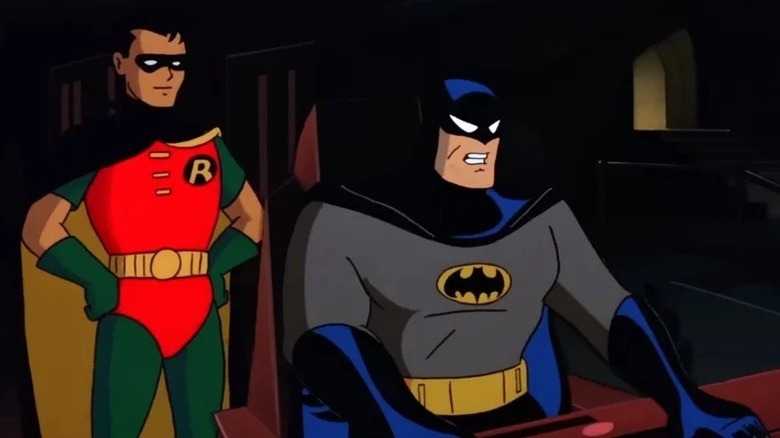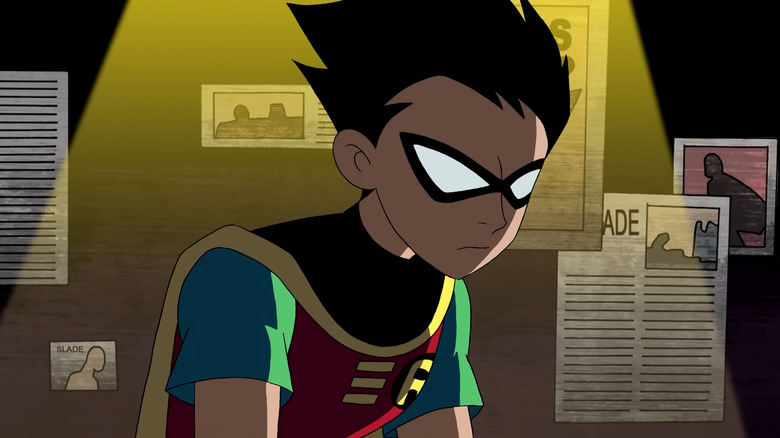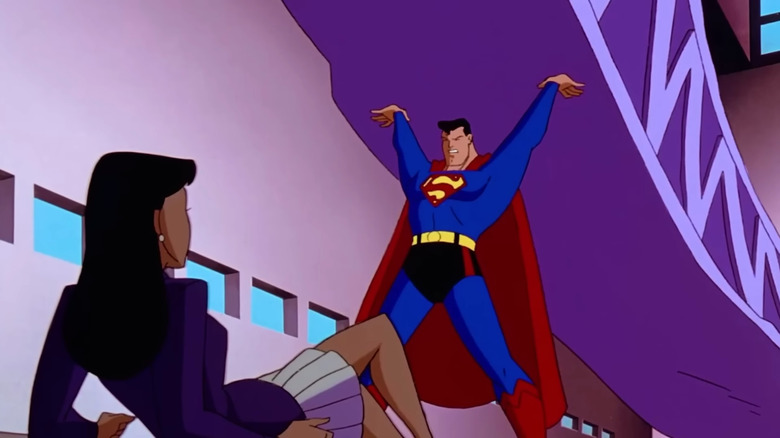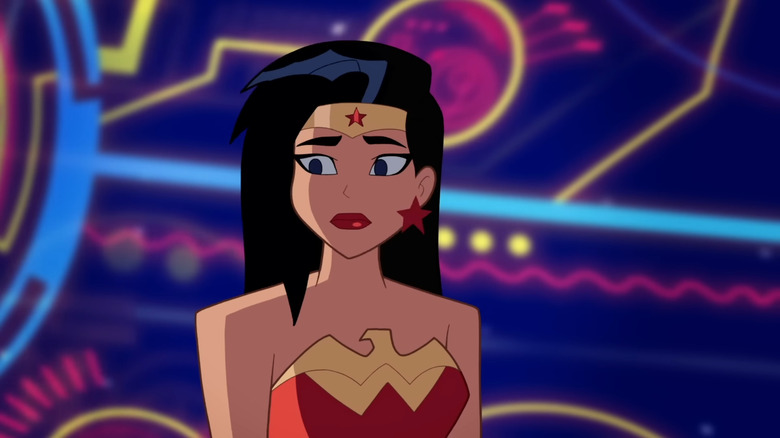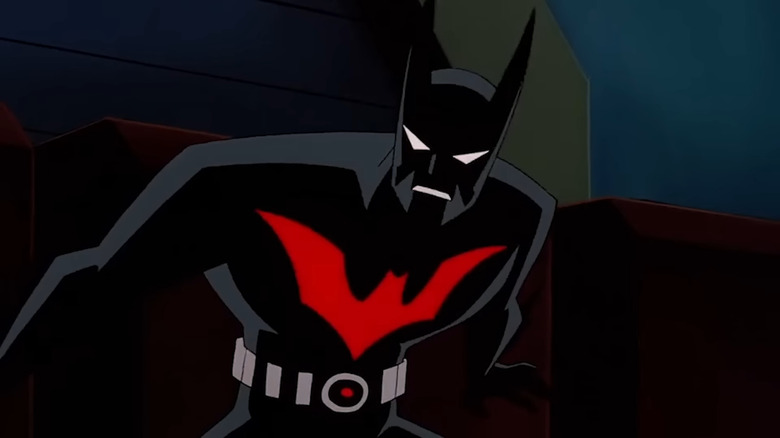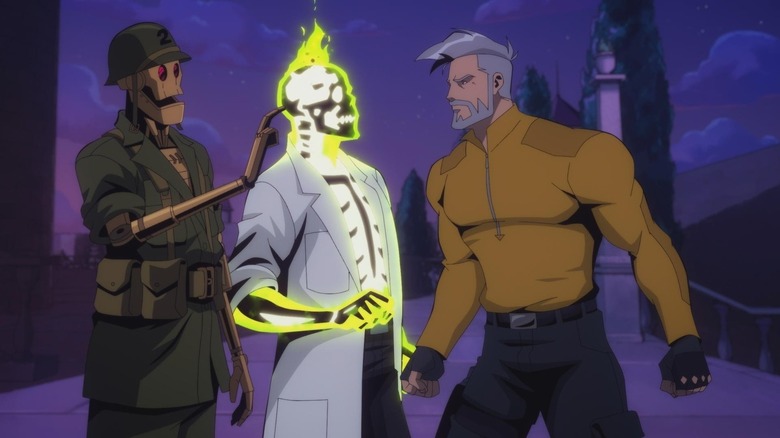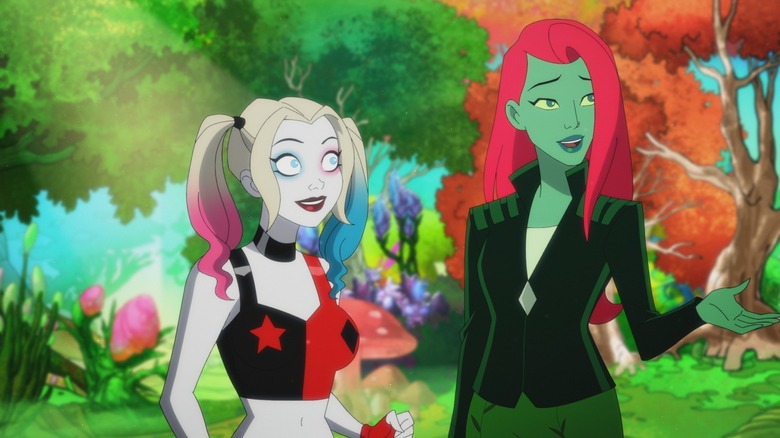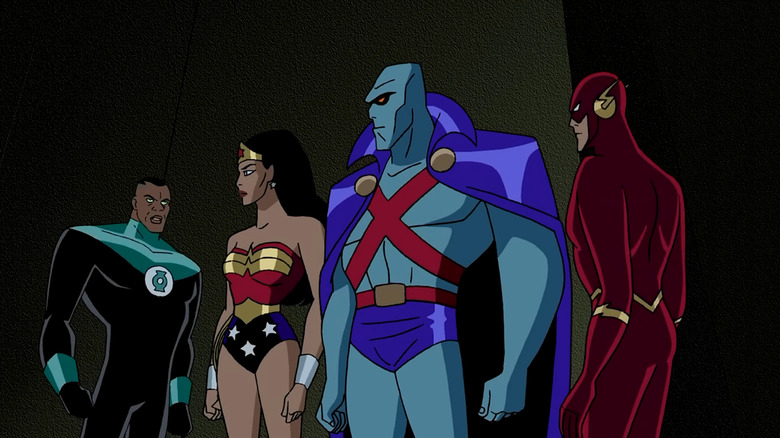10 Best Animated DC Comics TV Shows Of All Time
It's not outrageous to say that DC's animated TV shows outperform its live-action series and films. The reason for this is simple: It's all killer, no filler. When it comes to the world of animation, DC not only delivers the best in class in its genre, but also some of the greatest TV series ever. Whether it's the modern-day "Harley Quinn" that revels in the hardcore zaniness and violence of the Clown Princess, or the generational passing of the Dark Knight's cowl in "Batman Beyond," there's something for everyone.
So, how do you pick the top 10 DC animated shows here? The methodology is as follows: One, the programs need to be generally beloved; of course there will always be the outlier who hates everything, but the overall consensus is that the shows are excellent. Two, the author (me) applied their 30-plus-year love for DC Comics to select the best of the best that captures the spirit of the characters. And three, only two Batman shows were allowed, since everyone knows this entire list could be composed of just the Dark Knight's shows alone.
So, let's get cracking and fill up those watchlists. Here are the 10 best animated DC Comics TV shows of all time (in no specific order).
Batman: The Animated Series
OK, there's no point in keeping this title buried until the end like it's some kind of a secret surprise, since everyone knows it's an absolute essential when discussing the best animated DC shows. In fact, "Batman: The Animated Series" is a strong contender for DC's best animated show of all time, as it combines masterful storytelling with an innovative art aesthetic known as Dark Deco. Plus, the show takes decades' worth of lore and manages to simplify it in a way that's both appealing to new and older fans of the Caped Crusader, staying true to the essence of the character but adapting the stories where necessary.
We'd be remiss not to mention the sensational voice cast. From the late Kevin Conroy's timeless take on Bruce Wayne and Batman to Mark Hamill becoming the most imitated Joker voice of all time, every character comes to life in a way that transcends generations. The show also has the uncanny ability to attract the talents of Hollywood mainstays, as names like Ed Asner, Ron Perlman, Roddy McDowall, and Adrienne Barbeau all contribute in some form here.
To this day, the series remains highly watchable and provides a few of the best origin retellings of the Bat's rogues' gallery. It's next to impossible to pick the best episodes from "Batman: The Animated Series" since they're all that good.
Teen Titans
Most viewers are familiar with the comedic reverence of the long-running "Teen Titans Go!" Before that show, though, there was "Teen Titans," an anime-inspired series about the same characters that ran between 2003 and 2006 on Cartoon Network. Created by Glen Murakami, the show centered on the core team of Robin (voiced by Scott Menville), Cyborg (Khary Payton), Beast Boy (Greg Cipes), Raven (Tara Strong), and Starfire (Hynden Walch) and featured a healthy dose of humor and heart (though it's decisively less zany and off-the-wall than "Teen Titans Go!"). Despite there being five main characters, there's an equal balance in the storytelling, affording every hero the chance to have their moment in the spotlight.
While "Teen Titans" adapted popular storylines from the comics, such as "The Judas Contract," the best moments in the show almost always occurred when Slade (Ron Perlman) was on screen. The villain wasn't known by his regular alias Deathstroke in the series, since the name might be too scary for a kids' show, but his special brand of chilling menace remained dialed up to 11. He was the ultimate antagonist, mixing up physical and psychological threats in an attempt to destroy his enemies.
"Teen Titans" received five seasons, but it felt too little because there was a unique charm to this version of the popular DC characters. As a matter of fact, many fans have still not forgiven the powers that be for canceling "Teen Titans" in the first place.
Superman: The Animated Series
The Fleischer "Superman" cartoons demonstrate the Man of Steel's awe-inspiring abilities, making everyone believe that he's faster than a speeding bullet, more powerful than a locomotive, and able to leap tall buildings in a single bound. However, they rarely show who he is as Kal-El, Clark Kent, and Superman. When it comes to this iconic superhero, it isn't only about superpowers, because each facet of his personality plays a fundamental role in understanding the range and depth of the character. Kicking off in 1996 and taking a page out of the book of "Batman: The Animated Series," "Superman: The Animated Series" provides a definitive and updated version of Big Blue, encapsulating every important element of his life from Krypton to Smallville and Metropolis.
"Wings" star Tim Daly brings the titular character to life with an inspired and delicate performance, showcasing how goodness can change the world and words prove more powerful than fists. Supporting Daly is Dana Delany as Lois Lane, David Kaufman as Jimmy Olsen, Clancy Brown as Lex Luthor, and Michael Ironside's highly underrated turn as Darkseid. Sure, the show might be centered around Superman, but every character adds their own magic to the proceedings.
Much like "Batman: The Animated Series," "Superman: The Animated Series" remains the go-to program for anyone wanting the full Superman experience. No other animated show has managed to represent the heart and soul of the Man of Steel, though Adult Swim's "My Adventures with Superman" comes pretty darn close.
Justice League Action
Superhero cartoons of the past had the ability to tell fully realized stories in under 10 minutes. In 2016, Warner Bros. and DC went back to the past with "Justice League Action," creating a series of compact cartoons that focused on largely standalone stories. By doing so, they unlocked the wider DC Universe and brought a number of lesser-seen characters, such as Plastic Man (Dana Snyder) and Jonah Hex (Trevor Devall), into the fray alongside the regular Justice League.
"Justice League Action" was designed for younger viewers, but thanks to its lighter tone, colorful characters, sharp animation, and terrific voice cast, it still held an appeal for older audiences. Kevin Conroy and Mark Hamill made their respective returns as Batman and Joker, while other recognizable actors — Sean Astin as Shazam, Lacey Chabert as Zatanna Zatara — also stepped into the recording booth as popular characters.
Clearly, "Justice League Action" valued fun over anything else, as there's even an episode titled "Follow That Space Cab!" that tells the story of a space cabbie (Patton Oswalt) helping Superman (Jason J. Clark) and Hawkman (Troy Baker) to stop Lobo (John DiMaggio) from kidnapping Mr. Mind (Oliver Vaquer). It's all bite-sized adventures that hit the sweet spot and make for the perfect viewing while you eat your breakfast or sip your morning coffee. "Justice League Action" only lasted a short while — barely two years — but it's an underrated animated DC TV gem that deserves more credit than it gets.
Batman Beyond
Comic book fans aren't known for being receptive to change — quite the contrary. So, imagine the surprise when "Batman Beyond" dropped — a show that saw high school student Terry McGinnis (Will Friedle) become the Batman of Neo-Gotham while Bruce Wayne (Kevin Conroy) took a supporting role as his mentor — and viewers ate it up like it's all-you-can-eat buffet.
The secret sauce of the series was how it didn't break canon; it respected and expanded it, providing a compelling answer of what would happen if Bruce could no longer be Batman and protect Gotham from all its criminal elements. There would be a need for someone else to step up and fill the void. In this case, it wasn't another member of the Bat-Family; it was Terry. However, Terry wasn't like Bruce at all. He was his own man, and this is what made him such a marvelous character to get behind as he carved out his own path as the Batman of the Future.
"Batman Beyond" didn't rely too heavily on nostalgia or revisiting the villains of the past. Instead, it produced newer stories and a fresh breed of antagonists — with familiar faces from the past still featuring in clever ways. The show stayed rooted in the animation style of other DC Animated Universe series, but it applied its own futuristic touch to the aesthetic. Plus, "Batman Beyond" also had a banger of an intro theme that deserves to be turned up to the max whenever it comes on.
Creature Commandos
One of the newer shows on the list is "Creature Commandos," which is created and written by DC Studios co-CEO James Gunn. Once again, this series demonstrates Gunn's inherent ability to take D-list comic book characters and turn them into a wacky and unforgettable team (see: "Guardians of the Galaxy" and "The Suicide Squad" for further proof). The premise for the show is simple: This isn't the Suicide Squad; it's Task Force M, a monstrous black ops team led by Rick Flag Sr. (Frank Grillo) to do Amanda Waller's (Viola Davis) bidding. Expectedly, this ragtag group isn't built to follow orders, or work as a cohesive unit.
Gunn pushes the show's R-rated boundaries and tickles the funny bone by letting the monsters run amok, but he also finds a way to humanize them in this story. Take Weasel (Sean Gunn) as a prime example. Everyone presumes the worst of the character, but the first season of "Creature Commandos" paints the true picture of who he really is, instantly turning him into a fan-favorite character in the new DC Universe. Additionally, Nina Mazursky (Zoë Chao) stands out as a tragic character whose fate will break the audience's hearts.
The first season of "Creature Commandos" sits pretty with a 95% critical approval rating and 78% audience score on Rotten Tomatoes. Considering how most shows need a season or two to find their true rhythm and hit top gear, "Creature Commandos" is already off to a promising start.
Young Justice
Created by Brandon Vietti and Greg Weisman, "Young Justice" focuses on the teenage sidekicks of the Justice League heroes. Sure, there's a bit of an overlap with "Teen Titans" in its basic concept, but this superhero show stands out by committing to its coming-of-age premise and amplifying the maturity of its storytelling. Don't be surprised to discover romance (looking at you, Superboy and Miss Martian), disappointment, and shocking betrayals, as "Young Justice" plays out more like a teen drama than a whimsical cartoon about capes and cowls.
The show initially ran for just two seasons between 2010 and 2013. However, the fans never gave up on it after its cancellation, begging and pleading for the series to return — and in 2019, their prayers were answered, as two more seasons of "Young Justice" were produced, expanding the story and catching us up with the beloved characters. The creators revealed they have plans for even more seasons, but it's up to the decision-makers to give them the thumbs-up to continue here.
Ultimately, if "Young Justice" ends on the note that it did, it was an extraordinary and high-quality run — and it returned from the dead!
Harley Quinn
In DC Comics, Harley Quinn started off as the Joker's sidekick and love interest before venturing off on her own, breaking free of the shackles of the abusive relationship she had with the Ace of Knaves. "Harley Quinn" is built on the same ground, exploring Harley's (Kaley Cuoco) life post-Joker, as she tries to regain her power, forms her own team, falls in love with Poison Ivy (Lake Bell), and experiences every kind of misadventure under the sun.
Like the character herself, the show isn't afraid to get nuts. It's unapologetically Harley, choosing to demonstrate a vision of Gotham City (and beyond) that's through a jester's lens rather than the tried-and-tested canonical approach. It also helps that the series is rated R and refuses to tone down any joke or situation, embracing adult themes to tell a mature story geared at the older audience. Much like "Creature Commandos," this isn't for kids at all.
Through all the wackiness and outlandishness, "Harley Quinn" is a rousing story about redemption. It's about someone who refuses to accept the treatment she experienced at the hands of an abuser and fights back to rebuild her life, creating the love and happiness she deserves. Also, make sure you check out the "Harley Quinn" spin-off, "Kite Man: Hell Yeah!"
Justice League
The Avengers are to Marvel what Justice League is to DC; it's the granddaddy of all team-ups. Now, as demonstrated on the live-action side, it isn't always easy to bring together all these big personalities in a satisfying movie. Yet, the "Justice League" animated series works because it learns from the "Star Trek" shows in terms of how to manage all its characters — essentially, not every character needs to be the MVP of each episode, but they all require development of their arcs throughout the course of a season.
The biggest advantage that "Justice League" has is that many of its characters were already introduced in "Batman: The Animated Series" and "Superman: The Animated Series." Resultantly, there isn't a need to rehash origin stories or reintroduce characters, since the audience is familiar with the heroes here; instead, it's all about getting sucked into the new adventures and how everyone operates as a team.
"Justice League" ran for two seasons between 2001 and 2004 before "Justice League Unlimited" replaced it. There really isn't much of a difference between the shows, though, as the latter continues the story after a brief time jump. As a matter of fact, most fans tend to treat both series as the same thing, since they take place in the same universe with the same characters.
Green Lantern: The Animated Series
Let's just say this: "Green Lantern: The Animated Series" is a forgotten relic of the 2010s due to the poor performance of the live-action film starring Ryan Reynolds. Released in 2011 — the same year as the movie — this CGI show arrived at a bad time for the Green Lantern Corps. It's a shame, because it got everything right that the film got wrong.
While "Green Lantern: The Animated Series" focused on Hal Jordan (Josh Keaton) as the protagonist, it figured out a way to include the other Lanterns in the story, as well. They never felt shoehorned, though, as the series doubled as a covert team-up spectacle that could have introduced even more fan-favorite Green Lanterns later on, had it survived beyond its sole season.
The worldbuilding done in the show was simply remarkable, as it dissected and investigated various aspects of the greater lore, such as the Red Lantern Corps, Guardians of the Universe, and the dreaded Anti-Monitor (Tom Kenny). Seriously, it did so much in just 26 episodes, and it was just getting started. "Green Lantern: The Animated Series" deserved to receive a longer and more celebrated run than it did, but don't let that take away from the fact that it's still one of the best animated DC TV shows of all time.

